Serving 1,321 students in grades 9-12, Francis Joseph Reitz High School ranks in the top 50% of all schools in Indiana for overall test scores (math proficiency is bottom 50%, and reading proficiency is bottom 50%).
The percentage of students achieving proficiency in math is 36% (which is lower than the Indiana state average of 38%). The percentage of students achieving proficiency in reading/language arts is 51% (which is higher than the Indiana state average of 41%).
The student:teacher ratio of 17:1 is higher than the Indiana state level of 15:1.
Minority enrollment is 17% of the student body (majority Black), which is lower than the Indiana state average of 37% (majority Hispanic).
Quick Stats (2025)
- Grades: 9-12
- Enrollment: 1,321 students
- Student:Teacher Ratio: 17:1
- Minority Enrollment: 17%
- Graduation Rate: 95% (Top 30% in IN)
- Overall Testing Rank: Top 50%
- Math Proficiency: 36% (Btm 50%)
- Reading Proficiency: 51% (Top 30%)
- Science Proficiency: 38% (Top 50%)
- Source: National Center for Education Statistics (NCES), IN Dept. of Education
School Overview
Francis Joseph Reitz High School's student population of 1,321 students has stayed relatively flat over five school years.
The teacher population of 78 teachers has declined by 40% over five school years.
Grades Offered
Grades 9-12
Total Students
1,321 students
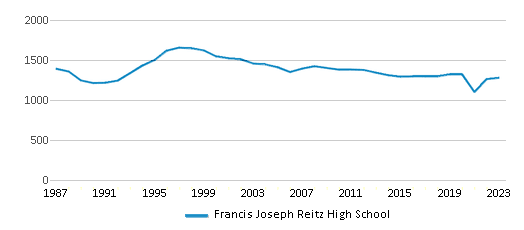
Gender %
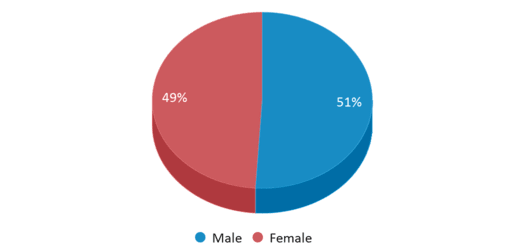
Total Classroom Teachers
78 teachers

Students by Grade
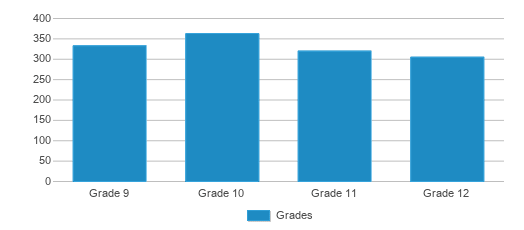
School Rankings
Francis Joseph Reitz High School ranks within the top 50% of all 1,763 schools in Indiana (based off of combined math and reading proficiency testing data).
The diversity score of Francis Joseph Reitz High School is 0.31, which is less than the diversity score at state average of 0.56. The school's diversity has stayed relatively flat over five school years.
Overall Testing Rank
#695 out of 1763 schools
(Top 50%)
(Top 50%)

Math Test Scores (% Proficient)
36%
38%

Reading/Language Arts Test Scores (% Proficient)
51%
41%
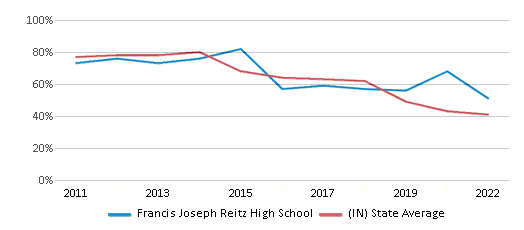
Science Test Scores (% Proficient)
38%
34%
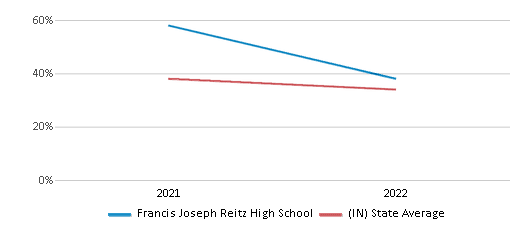
Student : Teacher Ratio
17:1
15:1
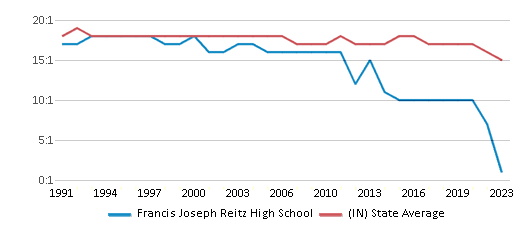
American Indian
n/a
n/a
Asian
1%
3%
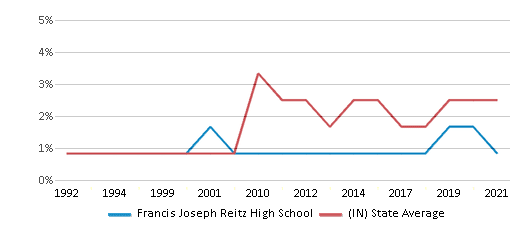
Hispanic
3%
15%
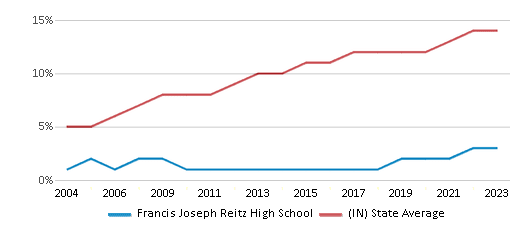
Black
6%
13%
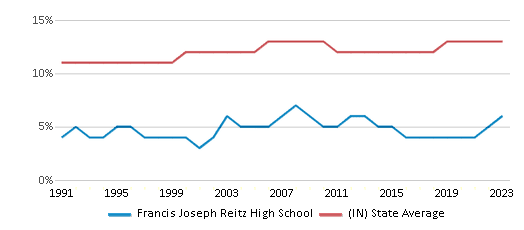
White
83%
63%
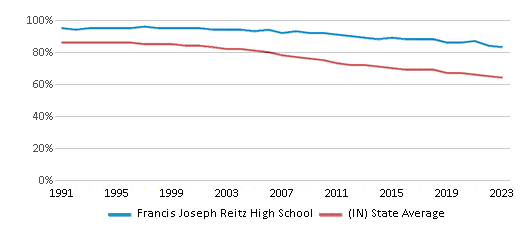
Hawaiian
1%
n/a
Two or more races
6%
6%
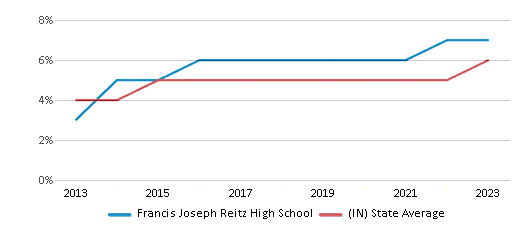
All Ethnic Groups
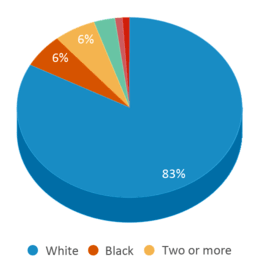
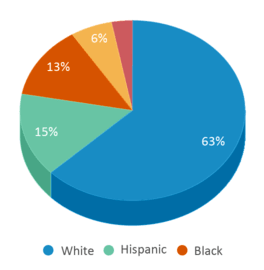
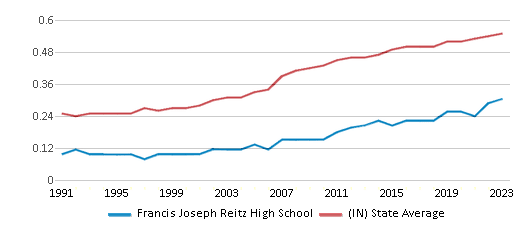
Graduation Rate
95%
88%

Eligible for Free Lunch
38%
43%
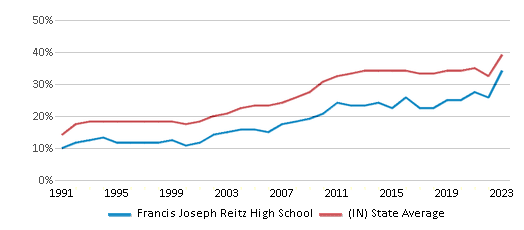
Eligible for Reduced Lunch
5%
6%
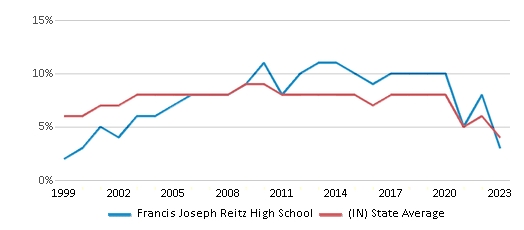
School Statewide Testing
School District Name
Source: National Center for Education Statistics (NCES), IN Dept. of Education
School Notes
- Francis Joseph Reitz High School is a historic public high school on the west side of Evansville, Indiana. It was founded in 1918, and is the second oldest high school still in use today in the city. It is a member of the Evansville Vanderburgh School Corporation.
- History: The idea for a school on the west side of Evansville came from the Centennial Club, led by Mrs. C.F. Werner, who fought a genteel, but determined battle with the reluctant school board. The ladies said the Evansville High School (old Central) was too far away to be financially practical for many west side families. After four years of crusading, the Centennial Club won.
- The school board had planned to call the school West Side High School. That was before the board discovered a lack of funds and Francis Joseph Reitz agreed to finance the building of the school. A grateful school board immediately voted that this new hall of learning (which incidentally cost $223,844.00) should be named after Mr. Reitz. Thus Francis Joseph Reitz High School became the first high school on the west side and the second in Evansville.
- At first Reitz was intended to be a Junior High School, including only seventh, eighth, and ninth grades, but as the student body grew older, the curriculum was geared to fit the needs of older students. Reitz graduated its first seniors in 1921.
- In September 1918 a two-story and basement building of brick and stone classic design was open. In 1921, the first year in which Reitz High School was fully accredited by North Central Association, the 10,000-seat Reitz Bowl was completed. In 1926, a four-story classroom building was added to the west end of the building. In 1956, an addition of a new office wing, nurse's suite, counselors' offices, home economics kitchen, dining rooms, sewing rooms, print shop, band and choir rooms, library, and study hall was added. In 1957, a five-story classroom wing, a second gym, seating more than 3,000, department offices, teachers' lounges, industrial shops, a new auditorium, a new cafeteria, and new restrooms were added. In 1973, a new greenhouse was completed. In 1977, a driving range on Barker Avenue was added to accommodate the Driver's Education Department. The Evansville-Vanderburgh School Corporation owns the land on which the range is located.
- The school evolved into a hodgepodge of corridors, floors, and rooms from additions over the years, yet Reitz was still the smallest high school in the area and had the smallest cafeteria. Finally the school board opted for renovation and after more than $26 million, Reitz celebrated its 80th anniversary in 1998 with a whole new look that makes it the largest and most advanced high school structure in Evansville.
- History on Reitz Home Museum: Francis Joseph Reitz was the eldest son of John Augustus Reitz, who had already made his fortune in lumber by the mid 1850's. After the death of FJ Reitz, the Catholic Diocese of Evansville was the owner of the home. It was the home of the first Bishop of Evansville. After discovering that the home was for sale the Reitz Home Preservation Society was formed and struck an agreement with the Catholic Diocese to take possession of the home in order to preserve its historical value. It was restored to its original state when owned by the Reitz family and turned into the Reitz Home Museum.
- School colors: Reitz's original school colors were orange and purple, but those were given to Lincoln High School during the first half of the century. After they gave away their colors they picked blue and gray, as Reitz sits on the Mason-Dixon Line, and blue and gray were the colors of the North and South during the Civil War.
- The Reitz Bowl: The Reitz Bowl, one of the great natural stadiums in the nation, was born by accident. It was originally planned as a retaining wall for the new F. J. Reitz High School. Foresight by a school member noted that with some small changes a football stadium could be made too. In 1921, the first year in which Reitz High School was fully accredited by North Central Association, the 10,000-seat Reitz Stadium was completed. The first two years was a reserve schedule and then in 1921 Reitz began varsity play.The Reitz Bowl, one of the great natural stadiums in the nation, was born by accident. It was originally planned as a retaining wall for the new F. J. Reitz High School. Foresight by a school member noted that with some small changes a football stadium could be made too. In 1921, the first year in which Reitz High School was fully accredited by North Central Association, the 10,000-seat Reitz Stadium was completed. The first two years was a reserve schedule and then in 1921 Reitz began varsity play.
- In 1931, Reitz played its first night game. Also in 1931, Reitz played Bosse an extra game for charity on December 4th. This was during the great depression. 1959 was the last Thanksgiving Day game in the State of Indiana, Reitz against Bosse. 1973 saw the new all transistor scoreboard go into effect. It was, as all past Reitz scoreboards, a gift of the West Side Nut Club. In 1974 Prescription Athletic Turf (PAT) was introduced to the Reitz Bowl. PAT is a method of draining and irrigation from pipes laid beneath the playing surface. What occurs during this process is the drainage of any excess water by a vacuum system when the field is flooded by rain, and irrigating water to the surface of the field when it is too dry.
- Along with PAT came the renovation of the bowl seating, walkways, and stairs. A new all weather track was added too. In 1976 all metal permanent type bleachers become a reality. Play Clocks were introduced to the Bowl in 1995, and 2003 saw a brand new sound system that rivals those in the Big Ten Conference.
- In addition to being the home site for Panthers football games, home site for nearby Catholic High School Mater Dei Wildcats football games, the Bowl also hosts the annual Drums on the Ohio drum & bugle corps competition.
- Famous alumni and faculty: Herman Byers, legendary football coach.
- Don Hanson, NFL player.
- Rudy Charles, Total Nonstop Action Wrestling senior referee.
- Matt Williams, producer of The Cosby Show, Home Improvement, and Roseanne.
Profile last updated: 02/09/2025
Frequently Asked Questions
What is Francis Joseph Reitz High School's ranking?
Francis Joseph Reitz High School is ranked #695 out of 1,763 schools, which ranks it among the top 50% of public schools in Indiana.
What schools are Francis Joseph Reitz High School often compared to?
Francis Joseph Reitz High Schoolis often viewed alongside schools like Central High School, North High School, William Henry Harrison High School by visitors of our site.
What percent of students have achieved state testing proficiency in math and reading?
36% of students have achieved math proficiency (compared to the 38% IN state average), while 51% of students have achieved reading proficiency (compared to the 41% IN state average).
What is the graduation rate of Francis Joseph Reitz High School?
The graduation rate of Francis Joseph Reitz High School is 95%, which is higher than the Indiana state average of 88%.
How many students attend Francis Joseph Reitz High School?
1,321 students attend Francis Joseph Reitz High School.
What is the racial composition of the student body?
83% of Francis Joseph Reitz High School students are White, 6% of students are Black, 6% of students are Two or more races, 3% of students are Hispanic, 1% of students are Asian, and 1% of students are Hawaiian.
What is the student:teacher ratio of Francis Joseph Reitz High School?
Francis Joseph Reitz High School has a student ration of 17:1, which is higher than the Indiana state average of 15:1.
What grades does Francis Joseph Reitz High School offer ?
Francis Joseph Reitz High School offers enrollment in grades 9-12
What school district is Francis Joseph Reitz High School part of?
Francis Joseph Reitz High School is part of Evansville Vanderburgh School Corp School District.
School Reviews
3 3/27/2020
I have mixed feelings about my time at Reitz. The classes are pretty easy because they're mostly geared towards students who can't pass ISTEP. Class sizes are large- most of my classes have 30+ people in them, besides AP classes. Take AP and dual credit as soon as possible. You can find some of the best teachers in those classes. The environment can be a little toxic at Reitz. There is also a large cheating issue, but this is manageable because the kids who cheat on their homework tend to fail the tests. Karma. I would suggest looking into magnet programs to further supplement your education that is offered by the EVSC.The clubs are pretty good here, and there is a large variety of sports to go to.
Review Francis Joseph Reitz High School. Reviews should be a few sentences in length. Please include any comments on:
- Quality of academic programs, teachers, and facilities
- Availability of music, art, sports and other extracurricular activities
Recent Articles

What Is A Charter School?
Explore the world of charter schools in this comprehensive guide. Learn about their history, how they operate, and the pros and cons of this educational innovation. Discover key facts about charter schools, including admission policies, demographics, and funding, as well as what to look for when considering a charter school for your child.

10 Reasons Why High School Sports Benefit Students
Discover the 10 compelling reasons why high school sports are beneficial for students. This comprehensive article explores how athletics enhance academic performance, foster personal growth, and develop crucial life skills. From improved fitness and time management to leadership development and community representation, learn why participating in high school sports can be a game-changer for students' overall success and well-being.

February 05, 2025
Understanding the U.S. Department of Education: Structure, Impact, and EvolutionWe explore how the Department of Education shapes American education, from its cabinet-level leadership to its impact on millions of students, written for general audiences seeking clarity on this vital institution.





